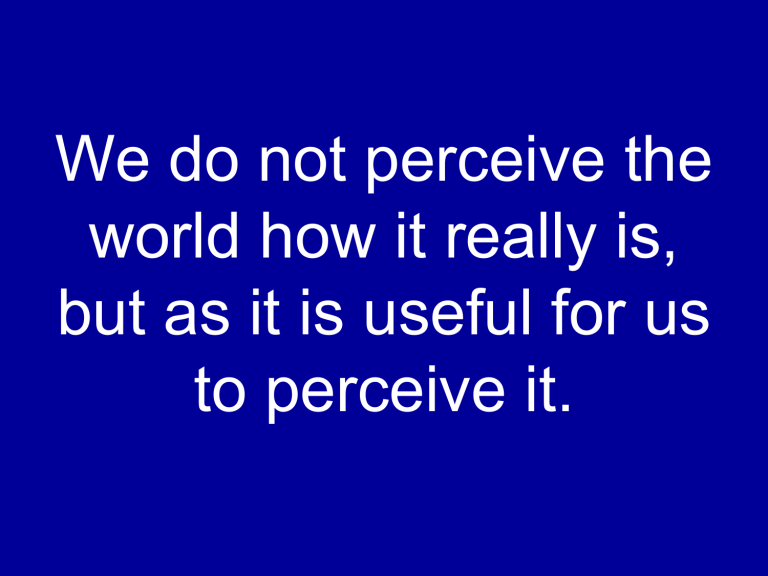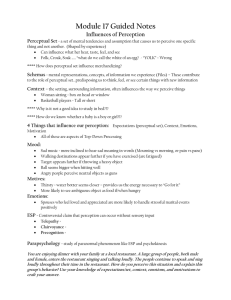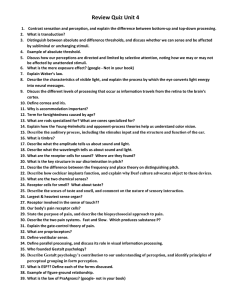We do not perceive the world how it really is,

We do not perceive the world how it really is, but as it is useful for us to perceive it.
Perception
The process of organizing and interpreting information we get from our senses
• enables us to recognize meaningful objects and events.
In transforming sensations into perceptions, we create the meaning
Selective Attention
• Any moment we focus our awareness on only a limited aspect of all that we experience
• Example– directions video
Cocktail Party Effect
• Ability to attend selectively to only one voice among many
Visual Capture
The dominance of vision over other sense modalities, such that what is felt or heard conforms to what is seen.
Perceptual Illusions
• Once we have attended to certain stimuli, how do we organize them into meaningful perceptions?
• Dalmatian Picture
Perceptual Illusions
Perceptual Illusions
Perceptual Illusions
Perceptual Illusions
Perceptual Illusions
Perceptual Illusions
Perceptual Illusions
Visual Capture
• When vision competes with other senses, vision usually wins- known as visual capture
• For example- watching a movie, in theatres we believe the sound is coming from the screen where people are talking, when really, it’s not
Perceptual Organization
• To transform sensory information into meaningful perceptions, we must organize it
• We must perceive objects as distinct from their surroundings, see them as having a meaningful and constant form, and discern their distance and motion.
Gestalt
• German scientist became intrigued with how the mind organizes sensations into perceptions
• Given a cluster of sensations, the human perceiver organizes them into a gestalt
• Described principles by which we organize our senses into perceptions
Gestalt Psychology
• Gestalt means “an organized whole”
• These psychologists were concerned with how and why we GROUP objects together.
• They stated that humans can not help but perceive stimuli in groups rather than individual or isolated elements
This explains why we see a cube and not a set of isolated holes or circles
Perceptual Organization: Gestalt
Grouping
the perceptual tendency to organize stimuli into coherent groups
Grouping Principles
proximity --group nearby figures together
similarity --group figures that are similar
continuity --perceive continuous patterns
closure --fill in gaps
connectedness --spots, lines, and areas are seen as unit when connected
Perceptual Organization:
Grouping Principles
• We group nearby figures together.
Proximity
Proximity
• Grouping nearby figures together
3 sets of parallel lines not six separate lines
Similarity
• Figures similar to each other we group together.
Similarity
• Grouping together figures that are similar to each other
9 separate shapes
Or
Two columns and one
Column?
Continuity
• We perceive smooth, continuous patterns rather than discontinuous ones
Continuity
• Perceiving smooth continuous patterns not discontinuous ones
Connectedness
• When they are uniform and linked, we perceive spots, lines, or areas as a single unit
Perceptual Organization:
Closure
We fill in gaps to create a complete, whole object
Closure
• Filling in gaps to create a complete, whole object
Perceptual Organization
Figure and Ground-organization of the visual field into objects (figures) that stand out from their surroundings (ground)
Warm-Up
1. What is perception?
2. Give an example of bottom-up processing
3. Explain Gestalt Psychology and give one example of grouping.
4. Explain Cocktail Party Effect
Perception
Our perceptions are affected by the biology of our sensory systems, but also by our previous experiences and cultural expectations.
Or in other words our…
Schemas
Take a moment to write down a few adjectives to describe each person based on their pictures.
A B
Which one is better looking?
Perception is also often based on…
Perceptual Set
A bias to perceive one thing and not another when looking at things in our world
Sort of the same thing as a mental set
So in some ways it can cause us to make errors in judgments when we are trying to perceive the world through our senses
What do you see?
• What you see in the center is influenced by your perceptual set
Perceptual Set
Bill Clinton and who?
Perceptual Set-Schemas
Which is the real Madonna?
Perceptual Set-Schemas
• When we hold the eyes as a constant it is difficult to identify the correct Madonna. Now that the image is rotated it is easy to tell the difference.
Perceptual Illusions
Used to reveal how we normally organize and interpret sensations
Optical or Visual Illusions
Discrepancies between the appearance of a visual stimulus and its physical reality
Form Perception
• Figure-Ground
Relationship
• When we look at objects we see the object as the figure and its surroundings as the background
– Airplane in the sky
Depth Perception
The ability to see objects in three dimensions although the images that strike the retina are two dimensional.
Allows us to judge distance.
Perceptual Organization
Depth Perception
Visual Cliff
Used to test infants depth perception
How do we transform twodimensional objects to threedimensional perception?
Binocular Cues :
depth cues that depend on two eyes
•Monocular Cues :
•depth cues that depend on one eye
Perceptual Organization: Depth
Binocular cues
Perception
retinal disparity
images from the two eyes differ
closer the object, the larger the disparity
convergence
neuromuscular cue
two eyes move inward for near objects
Perceptual Organization: Depth
Perception
Monocular Cues
relative size
smaller image is more distant
interposition
closer object blocks distant object
relative clarity
hazy object seen as more distant
texture coarse --> close fine --> distant
Perceptual Organization: Depth
Perception
Monocular Cues (cont.)
relative height
higher objects seen as more distant
relative motion
closer objects seem to move faster
linear perspective
parallel lines converge with distance
relative brightness
closer objects appear brighter
Linear Perspective
Parallel lines seem to converge with distance.
Linear Perspective at Work
• Relative Size if we know that two objects are similar in size, the one that looks smaller is farther away
Relative Size
Interposition if something is blocking our view, we perceive it as closer
Motion Perception
What tools do we use to perceive motion…
Stroboscopic movement
Perceiving continuous movement
Example
• Movies
Flip Book Example
Phi Phenomenon
• An illusion of movement created when two or more adjacent lights blink on and off in succession.
Cataracts
• Definition: an eye disease in which the lens becomes covered in an opaque film that affects sight, eventually causing total loss of sight.
ESP
Three types of ESP:
1. Telepathy- mind to mind communication
2. Clairvoyance- perceiving events as they are taking place
3. Precognition- perceiving future events
Also associated with ESP, psychokinesis (“mind over matter”




